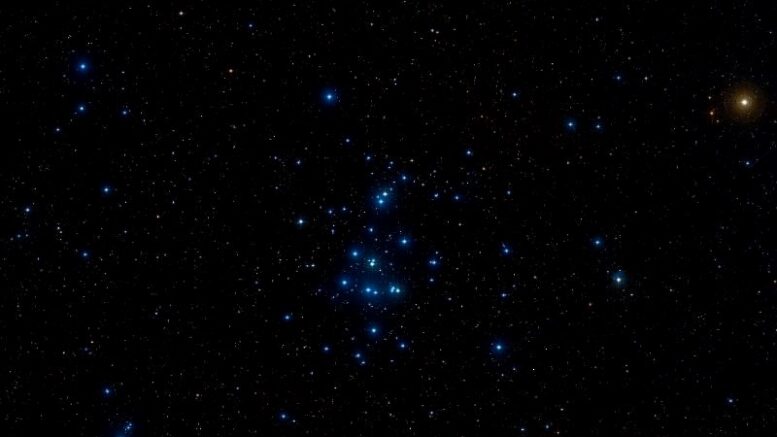The Beehive Cluster is an open cluster in the constellation Cancer. It is one of the nearest open clusters to Earth, containing a larger population of stars than other nearby bright open clusters. Under dark skies, the Beehive Cluster looks like a small nebulous object to the naked eye; as known since ancient times. Classical astronomer Ptolemy described it as “nebulous mass in the breast of Cancer”, and it was among the first objects that Galileo studied with his telescope.
| Description | |
| Visible From Pacific Northwest | October To March |
| Best Time To Observe | February and March |
| Minimum Size Of Viewing Device | Binoculars |
| Object Type | Open Cluster |
| Designations | Messier 44, M44, Praesepe, Beehive Cluster, the Manger, NGC 2632, Melotte 88, Cr 189, OCl 507.0, MWSC 1527 |
| Right Ascension | 08h 40.4m |
| Declination | 19°59′ |
| Constellation | Cancer |
| Number Of Stars | More Than 1,000 |
| Apparent magnitude | +3.7 |
| Apparent dimensions | 95′ |
| Object Radius | 8 light years |
| Distance From Earth | 577 light years |
History
Messier 44 is a prominent deep sky object and has been known since ancient times. Greek poet and philosopher Aratus mentioned Praesepe (the Manger) in his poem Phainomaina or Phainomena (Heavenly Phenomena, or Appearances) in 260 B.C.
Greek and Roman observers saw the cluster as a manger from which two donkeys are eating. The donkeys, represented by the nearby stars Asellus Borealis and Asellus Australis (Gamma and Delta Cancri), were the mythical animals on which the god Dionysus and his companion Silenus rode into battle against the Titans. In the myth, the Titans were frightened by the donkeys’ braying, which helped the gods win the battle. The donkeys were placed in the sky as a reward, along with the Manger, or Phatne in Greek.
Greek astronomer Claudius Ptolemy (AD 90 – 168) also documented the cluster, calling it “the nebulous mass in the breast of Cancer.”
Messier 44 was one of the first deep sky objects that Galileo Galilei studied with his telescope in 1609. He was able to resolve 40 stars. He wrote, “The nebula called Praesepe contains not one star only but a mass of more than 40 small stars. We have noted 36 besides the Aselli [Gamma and Delta Cancri].”
Charles Messier added the Beehive Cluster to his catalogue on March 4, 1769, describing it as a “cluster of stars known by the name of the nebula in Cancer.”
In 2012, scientists discovered two planets orbiting two separate stars in the Beehive Cluster. These were the first planets discovered orbiting Sun-like stars in a star cluster.
Locating M44 In The Sky
Another faint constellation, Lynx, lies to the north, while Canis Minor, with the bright star Procyon, lies to the south of M44. An easy way to find the cluster is to draw a line from Pollux in Gemini to Regulus in Leo. M44 lies about halfway along the line.
The best time of year to observe the Beehive Cluster is from February to May, when Cancer rises high in the sky for northern observers.
The constellation is pretty faint, but it lies between two considerably brighter zodiac constellations, Leo to the east and Gemini to the west.

Viewing M44
M44 is one of the nearest open clusters to Earth and can easily be seen without binoculars. It appears as a blurry patch of light to the naked eye. The cluster is best seen in binoculars and small telescopes. Occupying an area 95 arc minutes across, it fits in the field of view of binoculars and low power telescopes. Larger telescopes reveal more than 200 stars in the cluster.
Photographing M44
The Beehive cluster may not look very exciting visually, but becomes really impressive through astrophotography. In photographs, M44 shows its large size and its stars, mostly white and blue, with some smaller ones being red and orange, shine with a wide variety of brightness. You can see that unlike many other popular open clusters, the stars in Messier 44 have plenty of space to breathe between one another.
It is indeed possible to image Messier 44 using a DSLR with relatively few exposures. Using a telescope is not necessarily required to photograph M44, but having autoguiding will definitely assist with collection.
Sources And Further Reading
Descriptions of all of Messier Objects can be found here.
https://www.messier.seds.org/m/m044.html
https://freestarcharts.com/messier-44

Leave a comment